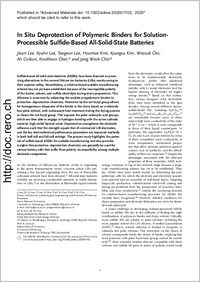In situ deprotection of polymeric binders for solution‐processible sulfide‐based all‐solid‐state batteries
- Lee, Jieun School of Chemical and Biological Engineering and Institute of Chemical Processes, Seoul National University 1 Gwanak‐ro, Gwanak‐gu Seoul 08826 Republic of Korea
- Lee, Kyulin School of Chemical and Biological Engineering and Institute of Chemical Processes, Seoul National University 1 Gwanak‐ro, Gwanak‐gu Seoul 08826 Republic of Korea
- Lee, Taegeun School of Chemical and Biological Engineering and Institute of Chemical Processes, Seoul National University 1 Gwanak‐ro, Gwanak‐gu Seoul 08826 Republic of Korea
- Kim, Hyuntae School of Chemical and Biological Engineering and Institute of Chemical Processes, Seoul National University 1 Gwanak‐ro, Gwanak‐gu Seoul 08826 Republic of Korea
- Kim, Kyungsu Advanced Batteries Research Center, Korea Electronics Technology Institute 25 Saenari‐ro, Bundang‐gu Seongnam Gyeonggi 13509 Republic of Korea
- Cho, Woosuk Advanced Batteries Research Center, Korea Electronics Technology Institute 25 Saenari‐ro, Bundang‐gu Seongnam Gyeonggi 13509 Republic of Korea
- Coskun, Ali Department of Chemistry, University of Fribourg Chemin de Musee 9 Fribourg 1700 Switzerland
- Char, Kookheon School of Chemical and Biological Engineering and Institute of Chemical Processes, Seoul National University 1 Gwanak‐ro, Gwanak‐gu Seoul 08826 Republic of Korea
- Choi, Jang Wook School of Chemical and Biological Engineering and Institute of Chemical Processes, Seoul National University 1 Gwanak‐ro, Gwanak‐gu Seoul 08826 Republic of Korea
-
07.08.2020
Published in:
- Advanced Materials. - 2020, p. 2001702
English
Sulfide‐based all‐solid‐state batteries (ASSBs) have been featured as promising alternatives to the current lithium‐ion batteries (LIBs) mainly owing to their superior safety. Nevertheless, a solution‐based scalable manufacturing scheme has not yet been established because of the incompatible polarity of the binder, solvent, and sulfide electrolyte during slurry preparation. This dilemma is overcome by subjecting the acrylate (co)polymeric binders to protection−deprotection chemistry. Protection by the tert‐butyl group allows for homogeneous dispersion of the binder in the slurry based on a relatively less polar solvent, with subsequent heat‐treatment during the drying process to cleave the tert‐butyl group. This exposes the polar carboxylic acid groups, which are then able to engage in hydrogen bonding with the active cathode material, high‐nickel layered oxide. Deprotection strengthens the electrode adhesion such that the strength equals that of commercial LIB electrodes, and the key electrochemical performance parameters are improved markedly in both half‐cell and full‐cell settings. The present study highlights the potential of sulfide‐based ASSBs for scalable manufacturing and also provides insights that protection−deprotection chemistry can generally be used for various battery cells that suffer from polarity incompatibility among multiple electrode components.
- Faculty
- Faculté des sciences et de médecine
- Department
- Département de Chimie
- Language
-
- English
- Classification
- Chemistry
- License
-
License undefined
- Identifiers
-
- RERO DOC 328907
- DOI 10.1002/adma.202001702
- Persistent URL
- https://folia.unifr.ch/unifr/documents/309072
Other files
Statistics
Document views: 107
File downloads:
- pdf: 693
- Supplementary material: 145

